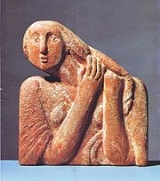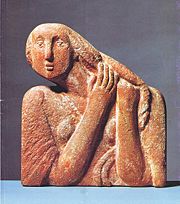
Katharina Szelinski-Singer
Encyclopedia
Katharina Szelinski-Singer, born as Katharina Singer (May 24, 1918, in Neusassen, nearby Šilutė
, Klaipėda Region
- December 20, 2010, in Berlin
) was a German sculptress. She has lived in Berlin
since 1945.
 Katharina Szelinski-Singer was an accomplished sculptress who studied at the Berlin University of the Arts
Katharina Szelinski-Singer was an accomplished sculptress who studied at the Berlin University of the Arts
, where she was a master student of Richard Scheibe. Shortly after finishing her studies in the mid-fifties she was commissioned to do a sculpture for park "Hasenheide" in Berlin. The sculpture was intended to honour the German Trümmerfrau
en (German for: rubble women), those women who after the end of the Second world war played a major role in rebuilding the city by clearing up the rubble of the damaged buildings. This limestone
-sculpture
is until now her most well-known work in a public place. After several similar but smaller commissions she lived from 1956 till 1986 mainly from doing restoring work at the Charlottenburg Palace
.
Katharina Szelinski-Singer was considered to be an outsider in the art scene: Although following up a different career path she continued to sculpture, but till 1987 her work could only rarely be seen in exhibitions. This changed in 1987/1988, when the Georg-Kolbe
-Museum
showed her work in a large exhibition dedicated only to her. All in all 45 of her sculptures have been shown there.
Her work consists roughly of one hundred sculptures which are without exemption figurative. She is practically always showing bodies or heads of women; very often they are an image of herself or influenced by elements from her own life. With the sculpture series Köpfe (German for: Heads) she was able to free herself to some extent from the influence of her teacher Richard Scheibe and develop new ways to express herself. This resulted also in a more extensive usage of bronze
and gypsum
, after a long period of working with natural stone. Art experts judge her work to be in line with the so called "Berliner Bildhauerschule" (Berlin sculptor school).
She died December 20, 2010, at age 92, in Berlin and was buried at the Friedhof Heerstraße
.
Šilute
Šilutė is a city in the south of the Klaipėda County, Lithuania. The city was part of the Klaipėda Region and ethnographic Lithuania Minor. Šilutė was the interwar capital of Šilutė County and is currently the capital of Šilutė district municipality.-Name:...
, Klaipėda Region
Klaipėda Region
The Klaipėda Region or Memel Territory was defined by the Treaty of Versailles in 1920 when it was put under the administration of the Council of Ambassadors...
- December 20, 2010, in Berlin
Berlin
Berlin is the capital city of Germany and is one of the 16 states of Germany. With a population of 3.45 million people, Berlin is Germany's largest city. It is the second most populous city proper and the seventh most populous urban area in the European Union...
) was a German sculptress. She has lived in Berlin
Berlin
Berlin is the capital city of Germany and is one of the 16 states of Germany. With a population of 3.45 million people, Berlin is Germany's largest city. It is the second most populous city proper and the seventh most populous urban area in the European Union...
since 1945.

Berlin University of the Arts
The Universität der Künste Berlin, UdK is a public art school in Berlin, Germany, one of the four universities in the city...
, where she was a master student of Richard Scheibe. Shortly after finishing her studies in the mid-fifties she was commissioned to do a sculpture for park "Hasenheide" in Berlin. The sculpture was intended to honour the German Trümmerfrau
Trümmerfrau
Trümmerfrau is the German-language name for women who, in the aftermath of World War II, helped clear and reconstruct the bombed cities of Germany and Austria...
en (German for: rubble women), those women who after the end of the Second world war played a major role in rebuilding the city by clearing up the rubble of the damaged buildings. This limestone
Limestone
Limestone is a sedimentary rock composed largely of the minerals calcite and aragonite, which are different crystal forms of calcium carbonate . Many limestones are composed from skeletal fragments of marine organisms such as coral or foraminifera....
-sculpture
Sculpture
Sculpture is three-dimensional artwork created by shaping or combining hard materials—typically stone such as marble—or metal, glass, or wood. Softer materials can also be used, such as clay, textiles, plastics, polymers and softer metals...
is until now her most well-known work in a public place. After several similar but smaller commissions she lived from 1956 till 1986 mainly from doing restoring work at the Charlottenburg Palace
Charlottenburg Palace
Charlottenburg Palace is the largest palace in Berlin, Germany, and the only royal residency in the city dating back to the time of the Hohenzollern family. It is located in the Charlottenburg district of the Charlottenburg-Wilmersdorf burough.The palace was built at the end of the 17th century...
.
Katharina Szelinski-Singer was considered to be an outsider in the art scene: Although following up a different career path she continued to sculpture, but till 1987 her work could only rarely be seen in exhibitions. This changed in 1987/1988, when the Georg-Kolbe
Georg Kolbe
Georg Kolbe was the leading German figure sculptor of his generation, in a vigorous, modern, simplified classical style similar to Aristide Maillol of France.Kolbe was born in Waldheim ....
-Museum
Museum
A museum is an institution that cares for a collection of artifacts and other objects of scientific, artistic, cultural, or historical importance and makes them available for public viewing through exhibits that may be permanent or temporary. Most large museums are located in major cities...
showed her work in a large exhibition dedicated only to her. All in all 45 of her sculptures have been shown there.
Her work consists roughly of one hundred sculptures which are without exemption figurative. She is practically always showing bodies or heads of women; very often they are an image of herself or influenced by elements from her own life. With the sculpture series Köpfe (German for: Heads) she was able to free herself to some extent from the influence of her teacher Richard Scheibe and develop new ways to express herself. This resulted also in a more extensive usage of bronze
Bronze
Bronze is a metal alloy consisting primarily of copper, usually with tin as the main additive. It is hard and brittle, and it was particularly significant in antiquity, so much so that the Bronze Age was named after the metal...
and gypsum
Gypsum
Gypsum is a very soft sulfate mineral composed of calcium sulfate dihydrate, with the chemical formula CaSO4·2H2O. It is found in alabaster, a decorative stone used in Ancient Egypt. It is the second softest mineral on the Mohs Hardness Scale...
, after a long period of working with natural stone. Art experts judge her work to be in line with the so called "Berliner Bildhauerschule" (Berlin sculptor school).
She died December 20, 2010, at age 92, in Berlin and was buried at the Friedhof Heerstraße
Friedhof Heerstraße
The Friedhof Heerstraße cemetery is located at Trakehnerallee 1 , district of Charlottenburg-Wilmersdorf in Berlin, Germany, beneath the Olympiastadion. It covers an area of 149,650 square meters....
.

